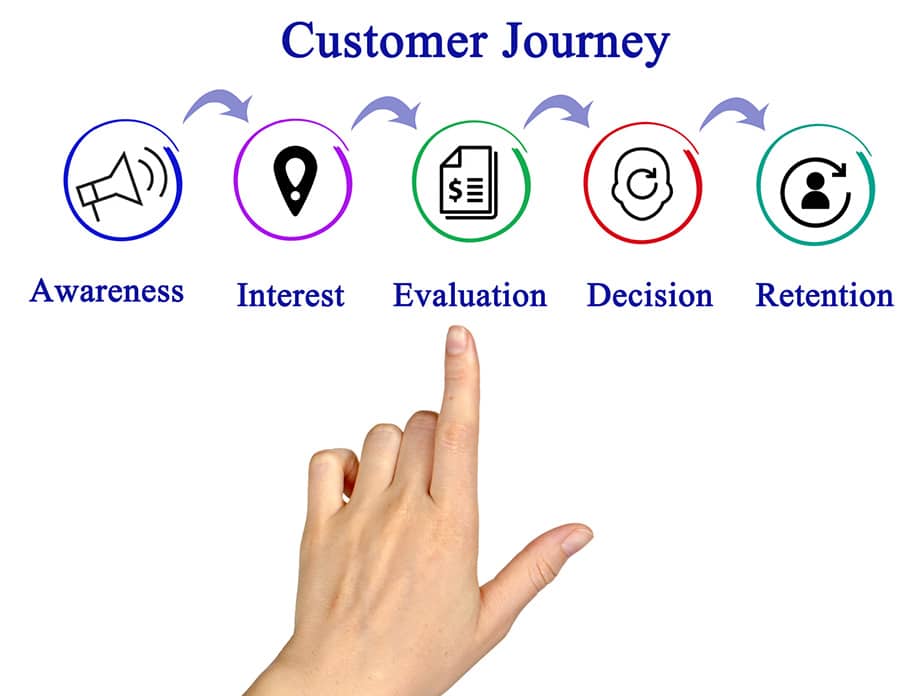A good marketing strategy incorporates the needs of a target audience to appeal to a consumer, but a genuinely great marketing strategy references those needs to define all marketing efforts. Enter a customer-centric marketing strategy, one that prioritizes consumers’ interests with personalized messaging and preferred communication channels tailored to the needs of the target audience.
There’s much to be gained by putting customers at the heart of your marketing. Organizations with a customer-focused marketing approach improve the ROI of marketing activities by upwards of 20%1 and are more than 60% more profitable than their competitors. To get in on the action, here’s what you need to know to create a customer-centric marketing strategy that converts.
What is Customer-Centric Marketing?
Customer-centric marketing provides personalized messaging and unique value propositions that aim to transform prospects to loyal consumers. It requires a thorough understanding of customer interests to create a throughline between what a customer needs and what your company offers.
In traditional marketing, one of the first steps to a successful strategy is getting to know your audience. Next, you must identify their shared pain points and target them accordingly via various advertising channels based on their online behaviors. Customer-centric marketing, however, takes getting to know your customers — and their needs — to the next level.
Instead of targeting a group with broad claims of what your product can accomplish, you provide individuals with distinct messaging that speaks to customer success and advocacy. In other words, customer-centric marketing focuses on personalizing the customer experience for ideal solutions rather than simply highlighting your product’s or service’s benefits.
The goal of customer-centric marketing is growth that continues to prove to customers that your product or service is a must-have to improve their life, professionally or personally. A customer-centric strategy should make a prospect feel as though they are part of something important, with transparent marketing that genuinely cares for the customer experience.
Creating a Customer-Centric Marketing Strategy
Now that you understand customer-centric marketing, it is time to implement the steps necessary to create a successful strategy. With this in mind, creating a customer-centric marketing campaign follows a series of steps, from conducting market research to understanding the customer journey.
Develop Buyer Personas and Conduct Market Research
With your target audience at the heart of your customer-centric strategy, it’s essential to begin your campaign with a detailed buyer persona and robust knowledge of relevant market research. To develop a buyer persona, start by defining your target audience or the specific group of consumers whose demographics make them potential buyers of your product or service.
Next, establish your buyer personas or the semi-fictional portrayals of individual target customers. Identifying the buyer persona in your customer-centric marketing helps craft content and messaging that targets their specific needs. Your personas should include general age ranges, interests, and price points — such as John Doe, the 40-year-old IT tech with a budget of $2,000 per month to streamline his internal processes.
Market research can speak to your industry, the opinions of customers, and how to deliver value above your competitors. Remember, your customer-centric marketing focuses on solutions. Market research via surveys, interests, and focus groups can help you position your offerings as a solution to your target audience’s needs.

Understand the Customer Journey
Identifying your ideal customer is the first step in any marketing strategy. You must dive deeper by understanding their journey to lead them to purchase your product. This entails understanding consumers and visualizing their feelings throughout touchpoints, which helps your brand make the best decisions. The customer journey defines their needs, problems, and interactions with your brand.
Mapping the customer journey provides you with a visual storyline. This could be a storyline for customer engagement about the product or brand, but it lays out every touchpoint and helps you visualize the customer experience. No matter why you are mapping out the journey, visualizing their experience unveils pain points and allows you to connect with the buyer and persuade them to purchase the offered product or service.
Survey Existing Customers and Prospects
There is no better way to learn about your customers than from the source. A robust customer-centric marketing strategy relies on soliciting ongoing feedback from current or former customers and those warm leads who have taken up space in your pipeline. So first up, consider surveying loyal customers to approach your strategy with their unique perspective.
A discussion with your current customers enables you to gain insight into the problems they were experiencing and why your product or service was their solution. Loyal customers can reveal the factors that placed your brand above the rest, from the quality of your offerings to your customer service level. You may be surprised by the elements that have turned your customers into loyal brand advocates, such as seamless returns or helpful customer support.
On the other hand, you should also survey new customers to learn what brought them to your brand in the first place. While it’s equally important to gauge the general problem or need your brand has fulfilled, newer customers can also provide a more current outlook on the marketing channels and touchpoints that entice leads to learn more about your product or service.
Lastly, one final option is to survey prospects to learn why they did not convert. Listening to these conversations helps you pinpoint where your customer-centric marketing strategy failed or which touchpoints did not accurately cater to the needs and wants of your audience. With this data, you can craft campaigns that better meet potential prospects where they’re at in the digital landscape.
Implement Personalization to Address Customer Needs
Look at every stage of the process and cross-reference with the customer journey and marketing touchpoints created earlier. Once you fully understand your customer and their needs, you can build tailored content that speaks to the unique pain points of potential consumers. More importantly, you can begin personalizing your marketing efforts to meet their needs.
Consider the touchpoints you uncovered while mapping your customer’s journey. For example, are you finding that most prospects visit your website at least once before bouncing, interact with your brand on another channel like social media, and then return to the website again? This could be a sign to implement a new marketing touch point to identify and address potential customer needs, like a more concise breakdown of pricing or a more straightforward method to schedule a demo on your site.
In a situation like this, you could send personalized emails to leads who have bounced — send an email soliciting feedback on the site or remind them of the product in their cart. Implement more personalized retargeting ads for customers who engage with your brand on Facebook. Even simple carousel-type advertisements with ad copy that mentions, “we think you’ll love these options,” signal that your brand is serving the customer, not the other way around.

How to Build Loyalty in a Customer-Centric Strategy
The ultimate goal of a customer-centric marketing strategy is to build long-term relationships with customers. Beyond simple brand awareness, a marketing campaign that caters to your customers’ needs can help forge loyal advocates for your brand. These customers will recommend you to friends and family, continue to drive conversions (often at higher values), and help you uphold a positive reputation in your industry. Here are some tips to build loyalty in your campaign.
Act on Customer Feedback and Suggestions
An effective customer-centric marketing campaign requires you to solicit ongoing feedback from customers and prospects — meaning you shouldn’t rely on the feedback you received in the strategy phase. Instead, you should prioritize your customer-centric strategy to actively seek feedback from current customers, past customers, and those in the pipeline.
Alternative methods other than surveys you can implement to learn more about your customers include:
- One-on-one interviews
- Mass email surveys with specific sets of questions
- Social listening tools and Google Alerts
- Customer emails and direct messages
- Customer support tickets
- Sales team calls
Remember, 70% of buying experiences3 are based on how the customer feels they are being treated. By actively soliciting customer feedback and implementing changes based on their collective suggestions, you indicate to customers that their opinion matters. The more you cater to your customer experience with ongoing feedback, the more you build loyal customers.
Constantly Convey Your Care to Customers
A whopping 86% of buyers will pay more for a better customer experience, but only 1% of customers feel that organizations consistently meet their expectations. Suppose you want your customer-centric strategy to meet customer expectations truly. In that case, you must clearly demonstrate that the consumer is at the center of your brand and not the other way around.
One way to show customers you care is to send surveys, such as those mentioned above, to keep a finger on the pulse of general satisfaction. Other methods to maintain a positive customer experience are to craft dedicated email sequences that check in with a buyer one week, one month, and three months after purchase. Each email initiates a new touchpoint for customers to share feedback, begin a secondary purchase, or feel part of a larger brand community.
Measuring the Success of Customer-Centric Strategies
Measuring the success of your customer-centric marketing strategy is critical in understanding its performance and continuously optimizing it. No matter how thoroughly created your campaign is, you will not see the success you desire without a clear understanding of how it performs.
You can measure success in customer-centric marketing with two metrics:
- Churn Rate. The rate that customers stop doing business with your brand, measured by the percentage of customers who discontinue subscriptions within a specific time.
- Customer Lifetime Value (CLV). The total worth of a customer over the whole period of their relationship with your brand, measured by the sum of the revenue acquired at each touch point over the average lifetime of that customer.
Start Building Your Customer-Centric Strategy Now
Bullseye Strategy offers data-driven, customer-centric marketing strategies that rise to meet the needs of any target audience. Our experts have more than a dozen years of experience building successful strategies that drive bottom-line results. If you’re interested in crafting a campaign that puts your customers first, contact Bullseye Strategy today for a free consultation.
- https://www.mckinsey.com/~/media/McKinsey/Business%20Functions/Marketing%20and%20Sales/Our%20Insights/EBook%20Big%20data%20analytics%20and%20the%20future%20of%20marketing%20sales/Big-Data-eBook.ashx
- https://www2.deloitte.com/content/dam/Deloitte/de/Documents/WM%20Digitalisierung.pdf
- https://www.mckinsey.com/~/media/McKinsey/Business%20Functions/Marketing%20and%20Sales/Our%20Insights/EBook%20Big%20data%20analytics%20and%20the%20future%20of%20marketing%20sales/Big-Data-eBook.ashx
- https://www.mckinsey.com/~/media/McKinsey/Business%20Functions/Marketing%20and%20Sales/Our%20Insights/EBook%20Big%20data%20analytics%20and%20the%20future%20of%20marketing%20sales/Big-Data-eBook.ashx







